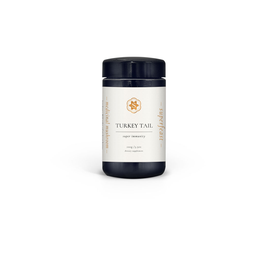Trametes mushroom is one of the most ubiquitous of the fungi kingdom, growing in many regions of the world with a well-documented historical usage spanned across many ancient cultures. It is known as the “turkey tail” mushroom in the West, as its fan shape bears a strong resemblance to the tail of a standing turkey.
Ancient Taoists prized the turkey tail fruiting body because it grew on evergreen pines (trees that were thought to hold deep yang energy within their roots). Thus, it was often prescribed in conditions of yang deficiency. Traditional Chinese medicine (TCM) classic texts often refer to its ability to dispel wind and damp whilst resolving upper respiratory infection, increasing stamina and treating abnormal cells. It is recognised as a Qi and Spleen, Lung and Liver supporting herb.
In Mexico and Asia, turkey tail is used to treat skin fungal infections and disorders and the indigenous Australians were known to use turkey tail to treat infections.
There is a reason that turkey tail is the most prolific mushroom in the entire world growing on nearly every continent and in all regions; because it is pure medicine for the human race. The immunological strength acquired when taking turkey tail is undeniable.
Turkey tail is a beautifully striated polypore found in temperate forests on all continents except Antarctica (have a look in your own backyard, or nearby nature reserve; it is highly likely there is some residing there!). The most rigorously studied of all mushrooms, several human studies support the use of turkey tail for modern-day disease prevention and as an adjunct treatment to bolster the immune system during medical procedures.
Sourcing:
Our carefully water-extracted turkey tail is wild-harvested Di Dao from China's Changbai Mountains. Turkey tail mainly grows on the dead, dying, or fallen branches of broad-leaf trees. They also grow on decaying coniferous trees such as larch and black pine.



![]() and then Add to Home Screen.
and then Add to Home Screen.
